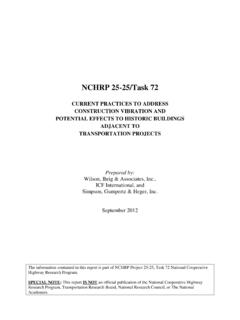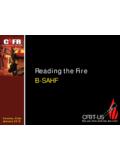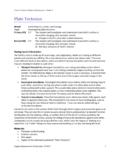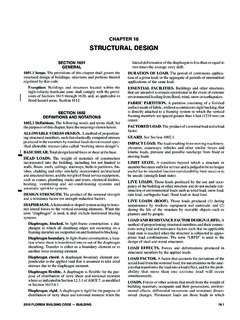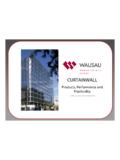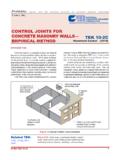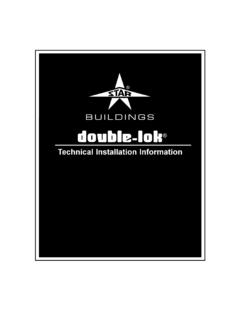Transcription of Technical Note: Water Vaper Permeance of Wood …
1 T e c h n i c a l n o t e Water Vapor Permeance of Wood Structural Panels and Wood Wall Construction Number J450. February 2009. Controlling against moisture damage in structures depends upon proper system design, installation and mainte- nance. The structural system must be designed to control against leaks, the major source of moisture damage, as well as condensation that may cause excessive moisture. Good construction practices control condensation within the walls and influence the rate at which Water vapor moves around and through wall system components, and mitigate the effects of humidity and temperature differentials between the inside and outside of the structure.
2 For more information, see APA Technical Note, Condensation Causes and Controls, Form X485. Wood, one of the most common building materials in North America, naturally contains some moisture within its cellular structure. The moisture content in wood changes as Water vapor moves in and out of the wood in response to temperature and humidity changes in the surrounding environment. Moisture content in wood is also affected by direct contact with liquid Water . Common sources of liquid- Water intrusion include Water leaks in the building enve- lope and leaks in Water pipes.
3 Absent sufficient drying potential, Water leaks can be damaging if they lead to high moisture content in wood for a prolonged period of time. However, Water leaks in the building envelope can be mini- mized through proper building design, construction and maintenance. More specific recommendations for minimiz- ing Water leaks through the proper design and construction of wood walls are presented in the Builder's Guide Series, available at Water may also accumulate within a wall in the form of Water vapor.
4 Water vapor is the result of air leaks allow- ing moisture-laden air into the wall cavity, or vapor diffusion through building components. Because moisture vapor can move through exterior wall systems, care must be taken with respect to the design of the wall to prevent excessive condensation. Condensation occurs when either Water vapor becomes too high or a surface temperature too low, such that a surface temperature drops below the dew point. Although controlling condensation involves many design aspects beyond the scope of this document, the topics addressed here the Water vapor Permeance of structural wood panels, vapor retarders and their role in wall-system design require careful consideration during the building design phase.
5 The proper placement of vapor retarders within a wall system will help manage the diffusion of vapor through the wall system. To determine proper vapor retarder placement and minimize moisture-related problems, the building designer must consider the interior and exterior environments, as well as the wall's thermal and Water vapor perme- ance characteristics (as discussed on the following pages). Water Vapor Permeance of Wood Structural Panels and Wood Wall Construction . Moi s tur e Mov e m e nt a n d Wate r Va por Pe r m e a nc e Water vapor Permeance is the rate of moisture movement through a material as a function of the Water vapor pressure gradient that can exist between two surfaces.
6 The Water vapor Permeance of panels is measured using ASTM Method E 96. This method combines a controlled environment with either a desiccant (dry-cup) or Water (wet-cup) to create a vapor pressure gradient. The resulting weight change over a specific time is used to calculate the Permeance per area and per unit of the vapor gradient. Values are reported in perms (grains* per hour, per ft 2, per inch of mercury vapor pressure) or in kg per Pascal per second per meter2. One perm is equal to x 10-11 kg/Pa-s-m2.
7 Vapor retarders limit the amount of Water vapor that passes through a wall assembly. Section 202 of the 2007. Supplement to the International Building Code (IBC ) and Section R202 of the 2007 Supplement to the International Residential Code (IRC ) classify a membrane as a Class I vapor retarder when it has a Permeance of perm or less, a Class II vapor retarder when it has a Permeance of greater than up to perms, and a Class III vapor retarder when it has a Permeance of greater than up to 10 perms, when tested in accordance with the desiccant method using Procedure A (dry-cup) of ASTM E 96.
8 Materials with higher perm ratings allow greater passage of Water vapor. A membrane with a Permeance of 5 perms or more is classified as vapor permeable in accordance with the 2006 IBC. and IRC. The Permeance of a material is inversely proportional to its thickness; in other words, two layers of a mate- rial will have one half the Permeance of a single layer of that material. Figure 1 displays the Water vapor Permeance of select building materials tested by the National Institute of Science and Technology (NIST) and Oak Ridge National Laboratory (ORNL).
9 The results show that the Water vapor perme- ance of plywood and oriented strand board (OSB) is sensitive to relative humidity gradients. For example, at 50. percent humidity, the Water vapor Permeance of 7/16-inch OSB sheathing is approximately 2 perms, but the Water vapor Permeance may be increased to 12 perms when the humidity is increased to about 85 percent. Both 15/32-inch plywood and 7/16-inch OSB are regarded as semi-permeable materials under the 2006 IBC and IRC. For comparison, the Water vapor Permeance of polyethylene and some extruded polystyrene products are very low and are generally insensitive to relative humidity gradients.
10 *A grain is 1/7000 of a pound Figure 1. Water vapor Permeance for building materials as a function of relative humidity 25. 15/32-inch plywood 20. 7/16-inch OSB. Permeance (Perms). 1/2-inch extruded polystyrene 15. 6 mil polyethylene 10. Sources: Developing Innovative Wall Systems that 5 Improve Hygrothermal Performance of Residential Buildings, Table 3 and Figure 68, Karagiozis, Oak Ridge National Laboratory; A Computer Analysis of Wall Constructions in the Moisture Control 0 Handbook, Figure 2, Burch & Sanders, 25 30 35 40 45 50 55 60 65 70 75 80 85.




